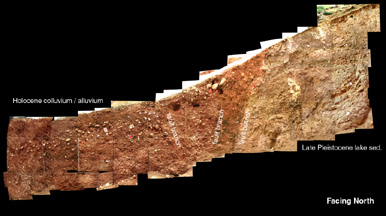

 Paleoseismic and neotectonic studies are being conducted in collaboration
with Mustapha Meghraoui (IPG Strasbourg) as well as Syrian and Lebanese
colleagues. Some examples are shown here.
Paleoseismic and neotectonic studies are being conducted in collaboration
with Mustapha Meghraoui (IPG Strasbourg) as well as Syrian and Lebanese
colleagues. Some examples are shown here.
Our first paleoseismic trench was opened along the Serghaya Fault zone
during the Spring of 2000 and revealed evidence of at least 5 large Holocene
earthquakes along this fault which has generally been regarded as inactive.
The photo above (facing south) shows the trench system parallel to and
crossing the 4 meter fault scarp. A mosaic of one of the trench walls
(left) depicts several.shear zones (click on photo for enlargement).
 During the Spring
of 2001, we excavated several trenches along the main Dead Sea fault system
(locally known as the Ghab fault) near the town of Misyaf (about 50 km north
of the Lebanese-Syrian border). This area is particularly interesting
because a Byzantine aqueduct has been displaced by about 9 meters at the fault
(see photo at right). Preliminary results suggest that this part of the
fault has not produced a large earthquake in the last ~800 years. The
precise timing of the 4 paleoseismic events documented in the trenches is being
refined with ongoing radiocarbon dating.
During the Spring
of 2001, we excavated several trenches along the main Dead Sea fault system
(locally known as the Ghab fault) near the town of Misyaf (about 50 km north
of the Lebanese-Syrian border). This area is particularly interesting
because a Byzantine aqueduct has been displaced by about 9 meters at the fault
(see photo at right). Preliminary results suggest that this part of the
fault has not produced a large earthquake in the last ~800 years. The
precise timing of the 4 paleoseismic events documented in the trenches is being
refined with ongoing radiocarbon dating.
Return to Dead Sea Project Home
For questions or comments, please contact Muawia Barazangi: mb44@cornell.edu.
Last updated: August 2006